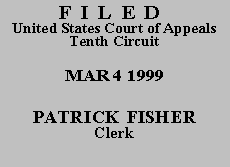

| TOMMY LEE CLEATON,
Petitioner-Appellant, v. STEVE HARGETT, Respondent-Appellee. |
|
Petitioner-appellant Tommy Lee Cleaton appeals the district court's dismissal of his petition for a writ of habeas corpus, brought pursuant to 28 U.S.C. § 2254. Because petitioner cannot make a substantial showing of the denial of a constitutional right, we deny his application for a certificate of appealability and dismiss the appeal.
After a jury trial, petitioner was convicted in Oklahoma state court of attempted robbery by fear, for which he received a twenty-year sentence. The Oklahoma Court of Criminal Appeals affirmed his conviction on June 5, 1995. On April 23, 1997, petitioner filed an application for post-conviction relief in the Oklahoma state district court. The application was denied on June 19, 1997. On October 10, 1997, petitioner attempted to appeal the denial to the Oklahoma Court of Criminal Appeals. Because petitioner's appeal was untimely, the state appellate court declined jurisdiction on October 22, 1997. Petitioner filed this federal habeas petition on November 18, 1997. The district court dismissed the petition as barred by the one-year statute of limitation established by the Antiterrorism and Effective Death Penalty Act of 1996 (AEDPA), Pub. L. 104-132, 110 Stat. 1214. This appeal followed.
Before we may entertain the appeal, petitioner must obtain a certificate of appealability by making a "substantial showing of the denial of a constitutional right." 28 U.S.C. § 2253(c)(1), (2). Where, as here, the district court has disposed of a habeas petition on procedural grounds, petitioner must make a substantial showing either that the procedural ruling itself denied him a constitutional right, or that the procedural ruling was incorrect and that it prevented the court from considering allegations in the petition demonstrating a constitutional violation. See Whitehead v. Johnson, 157 F.3d 384, 386 (5th Cir. 1998) (explaining that a petitioner seeking a certificate of appealability to challenge the dismissal of a habeas petition on a nonconstitutional ground first must make a credible showing that the district court erred, and then show that the underlying claims involve the denial of a constitutional right); see also Davis v. Johnson, 158 F.3d 806, 809 (5th Cir. 1998) (applying two-step analysis when habeas petition dismissed on procedural, nonconstitutional ground); United States v. Reed, No. 97-6316, 1998 WL 817750, at *2 (10th Cir. Nov. 27, 1998) (citing two-step analysis with approval) (unpublished disposition). We conclude petitioner is unable to make the requisite showing.
Because petitioner's state conviction became final prior to the AEDPA's enactment on April 24, 1996, under our case law he had one year from that date to file his application for federal habeas relief. See Hoggro v. Boone, 150 F.3d 1223, 1225-26 (10th Cir. 1998) (recognizing that when petitioner's conviction became final before the AEDPA's enactment, retroactivity concerns require allowance of one year from date of enactment to file a § 2254 petition); United States v. Simmonds, 111 F.3d 737, 746 (10th Cir. 1997) (same for § 2255 motions). In Hoggro, we held the provisions of 28 U.S.C. § 2244(d)(2) toll this judicially-extended one-year statute of limitation for time spent pursuing a "properly filed" application for post-conviction relief in state court. See 150 F.3d at 1226 & n.4.
Applying Hoggro, it is clear petitioner's federal habeas petition was untimely. The petition was filed on November 18, 1997 573 days after the AEDPA went into effect. Even after subtracting the 57 days during which petitioner had a properly filed application for post-conviction relief pending in state court, his federal habeas petition was still 151 days overdue. The district court was correct, therefore, in dismissing petitioner's action as time-barred, and therefore petitioner cannot show the denial of a constitutional right.
Petitioner's application for a certificate of appealability is DENIED, and the appeal is DISMISSED. The mandate shall issue forthwith.
Entered for the Court
Circuit Judge
*. This order and judgment is not binding precedent, except under the doctrines of law of the case, res judicata, and collateral estoppel. The court generally disfavors the citation of orders and judgments; nevertheless, an order and judgment may be cited under the terms and conditions of 10th Cir. R. 36.3.